By George Beccaloni, March 2018
Alfred Russel Wallace collected an estimated 5,000 new species (mostly animals) during his 8 year trip to the 'Malay Archipelago' (1854-62) and an unknown number during his earlier 4 year trip to Amazonia (1848-52) (many of his specimens were destroyed when his ship caught fire on the way back to Britain). He personally named 307 species (12 palms, 120 butterflies, 70 beetles and 105 birds) in 21 scientific articles and one book. At least 4,700 other new species were collected by him and his assistants and these were described in about 350 publications by leading amateur and professional naturalists. At least 250 of these species were named after Wallace, usually as wallacii or wallacei [for a list of species named after Wallace CLICK HERE]
Below is a selection of a few of the most 'iconic' (well known/beautiful/unusual) new species that Wallace collected during his 12 years of collecting in the tropics. I have selected taxa which are still recognised as being valid species i.e. taxa which are not now regarded as being junior synonyms of other species, or ones which have not been reclassified as subspecies.
1) PLANTS
Piassava Fiber Palm (Leopoldinia piassaba Wallace, 1853: 17). A palm from the Rio Negro Basin of Amazonia named by Wallace in his book Palm Trees of the Amazon and Their Uses. It is famous for being a source of piassava fiber, used for brooms, ropes, hats and baskets. The water resistant, long, tough yet flexible, brown fibers are produced abundantly on the margins of the old frayed leafstalks which hang down covering the trunk to the very base in a dense, beard-like mass. Wallace (1853) writes:
"It seems to have been used by the Brazilians from a very early period to form cables for the canoes navigating the Amazon. It is well adapted for this purpose, as it is light (the cables made of it not sinking in water) and very durable. It twists readily and firmly into cordage from the fibres being rough-edged, and as it is very abundant, and is procured and manufactured by the Indians, piassaba ropes are much cheaper than any other kind of cordage...
Before the independence of Brazil, the Portuguese government had a factory at the mouth of the Paduarí, one of the tributaries of the Rio Negro, for the purpose of making these cables for the use of the Pará arsenal, and as a government monopoly. Till within these few years the fibre was all manufactured into cordage on the spot, but it is now taken down in long conical bundles for exportation from Pará to England, where it is generally used for street sweeping and house brooms, and will probably soon be applied to many other purposes. It is cut with knives by men, women and children, from the upper part of the younger trees, so as to secure the freshest fibres, the taller trees which have only the old and half-rotten portion within reach, being left untouched. It is said to grow again in five or six years, the fibres being produced at the bases of the new leaves. The trees are much infested by venomous snakes, a species of Craspedocephalus, and the Indians are not unfrequently bitten by them when at work, and sometimes with fatal consequences."

Illustration of Leopoldinia piassaba from Wallace, 1853.
Catinga Palm (Euterpe catinga Wallace, 1853: 27). Another Brazilian palm named by Wallace. The stems are used in house construction, the leaves are used for thatching temporary shelters, and mature fruits are occasionally used to make a drink. Wallace (1853) writes "The preparation of the fruit of this species [a drink] is sweeter and more finely flavoured than that of any other, and is therefore much sought after..."

Illustration of Euterpe catinga from Wallace, 1853.
2) INVERTEBRATES
Wallace's Two-clubbed Spider (Friula wallacei Pickard-Cambridge, 1897: 1009). This peculiar spider, a member of the subfamily Gasteracanthinae, is currently only known from the single specimen Wallace collected in Sarawak, which is preserved in the Oxford Museum of Natural History, UK. Marchant (1916) in his book about Wallace published the following note that Pickard-Cambridge who named this species had sent him:
"Some years ago, on looking over some insect drawers in my collection, Mr. A. R. Wallace exclaimed, ‘Why, there is my old Sarawak spider!’ ‘Well! that is curious,’ I replied, ‘because that spider has caused me much trouble and thought as to who might have caught it, and where; I had only lately decided to describe and figure it, even though I could give the name of neither locality nor finder, being, as it seemed to me, of a genus and species not as yet recorded; also I had, as you see, provisionally conferred your name upon it, although I had not the remotest idea that it had anything else to do with you.’ ‘Well,’ said Mr. Wallace, ‘if it is my old spider it ought to have my own private ticket on the pin underneath.’ ‘It has a ticket,’ I replied, ‘but it is unintelligible to me; the spider came to me among some other items by purchase at the sale of Mr. Wilson Saunders’ collections.’ ‘If it is mine,’ said Wallace (examining it), ‘the ticket should be so and so. And it is! I caught this spider at Sarawak, and specially noted its remarkable form. I remember it as if it were yesterday, and now I find it here, and you about to publish it as a new genus and species to which, in total ignorance of whence it came or who caught it, you have given my name!’ Thus it stands, and ‘Friula Wallacii, Camb. (family Gasteracanthidæ), taken by Alfred Russel Wallace at Sarawak,’ is the (unique as I believe) type specimen, in my collection."

Drawing of Friula wallacei from Pickard-Cambridge, 1897

Holotype of Friula wallacei in Oxford University Museum. Photograph by Joseph Koh.
Wallace's Cyriopalus Beetle (Cyriopalus wallacei Pascoe, 1866: 530). Collected by Wallace in Sarawak, Borneo. This species has also been found in Myanmar, Sumatra, Laos, Peninsular Malaysia and Thailand.

Illustration of Cyriopalus wallacei from Pascoe, 1866
Wallace’s Longhorn Beetle (Batocera wallacei Thomson, 1858: 447). A species discovered by Wallace on the Aru Islands. This species probably has the longest antennae of any beetle, measuring around 230mm in length.
Illustration of Batocera wallacei from Thomson, 1858
Wallace's Jewel Beetle (Calodema wallacei Deyrolle, 1864: 78). Collected by Wallace in New Guinea. Wallace calls this species "...one of the handsomest of the Buprestidae..." in his book The Malay Archipelago.
Illustration of Calodema wallacei from Deyrolle, 1864
Kei Jewel Beetle (Chrysodema calepyga Thomson, 1858: 430 = Cyphogastra calepyga). Collected by Wallace on Kei Island. Wallace writes the following about his capture of this species in The Malay Archipelago: "Of one grand new beetle, glittering with ruby and emerald tints, I got a large quantity, having first detected one of its wing-cases ornamenting the outside of a native's tobacco pouch. It was quite a new species, and had not been found elsewhere than on this little island. It is one of the Buprestidae, and has been named Cyphogastra calepyga."

Illustration of Chrysodema calepyga from Thomson, 1858
Wallace's Stag Beetle (Cladognathus wallacei Parry, 1862: 109 = Prosopocoilus wallacei). Wallace collected one specimen (a male) on Halmahera Island. Males have greatly enlarged jaws and can measure up to about 74 mm in length. This species is also found on Bacan, Ternate, Morotai and Seram islands.

Illustration of Cladognathus wallacei from Parry, 1864.
Rajah Brooke's Stag Beetle (Lucanus brookeanus Snellen Van Vollenhoven, 1861: 107 = Odontolabis brookeana). This species was collected by Wallace in Sarawak, Borneo and named after the ruler Rajah James Brooke.


Illustration of Lucanus brookeanus from Snellen Van Vollenhoven, 1861 (left) and a specimen of this species from Wallace's private collection now in London's Natural History Museum (right).
Wallace's Flower Chafer (Lomaptera wallacei Thomson, 1858b: 426 = Ischiopsopha wallacei). Collected by ARW in the Aru Islands. He notes that it is "Rather plentiful, flying in hot places in the forest, and settling on rotten stumps." (Wallace, 1868a).

Illustration of Lomaptera wallacei from Thomson, 1858b
Glorious Tiger Beetle (Cicindela gloriosa Schaum, 1861: 70 = Cicindela (Thopeutica) gloriosa). Wallace discovered this species in north Sulawesi Island, Indonesia. In his book The Malay Archipelago he wrote:
"...it was in the mountain torrent of the ravine itself that I got my finest things. On dead trunks overhanging the water and on the banks and foliage, I obtained three very pretty species of Cicindela, quite distinct in size, form, and colour, but having an almost identical pattern of pale spots. I also found a single specimen of a most curious species with very long antennæ. But my finest discovery here was the Cicindela gloriosa, which I found on mossy stones just rising above the water. After obtaining my first specimen of this elegant insect, I used to walk up the stream, watching carefully every moss-covered rock and stone. It was rather shy, and would often lead me a long chase from stone to stone, becoming invisible every time it settled on the damp moss, owing to its rich velvety green colour. On some days I could only catch a few glimpses of it, on others I got a single specimen, and on a few occasions two, but never without a more or less active pursuit. This and several other species I never saw but in this one ravine."
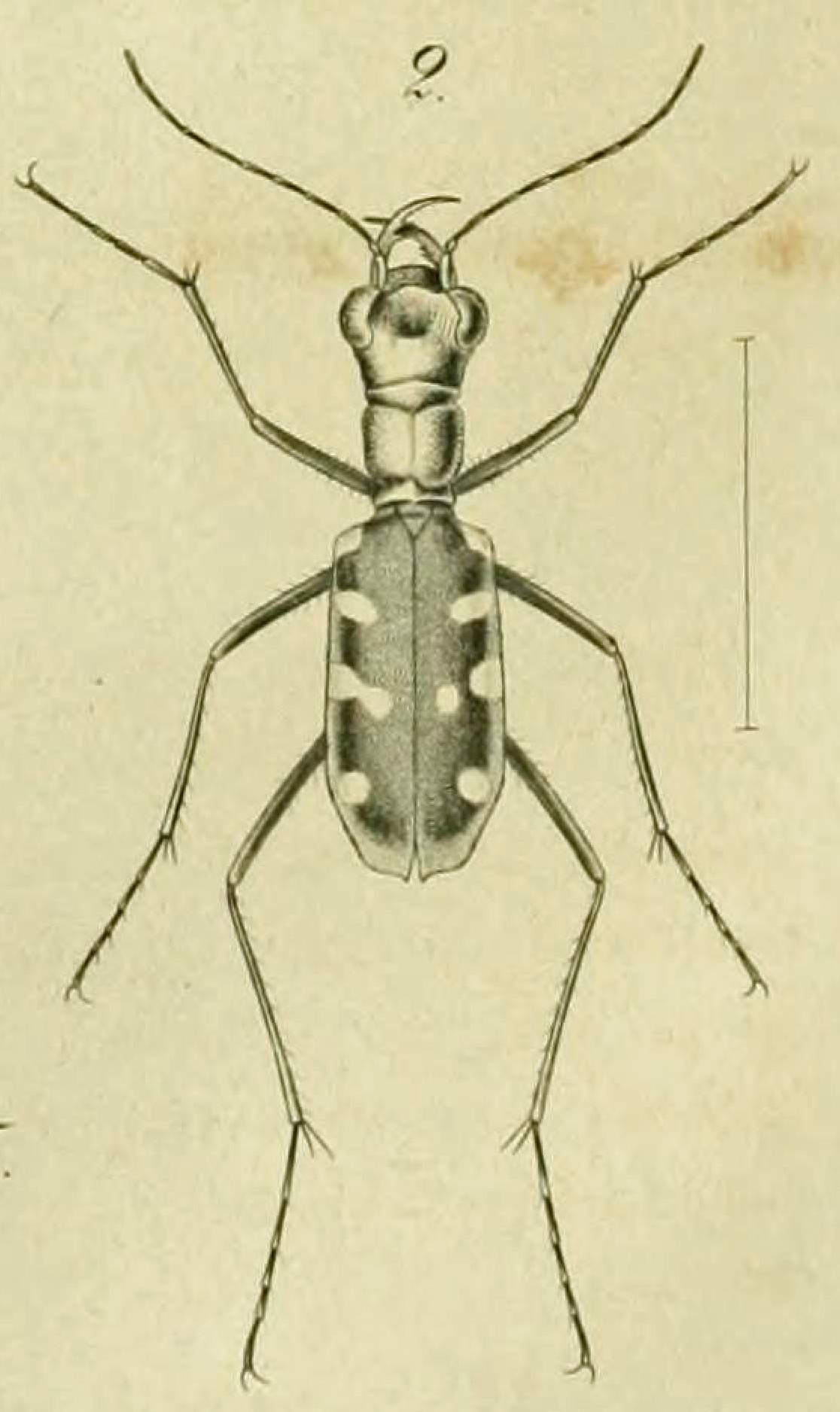
Illustration of Cicindela gloriosa from Schaum, 1861.
Wallace's Giant Bee (Megachile pluto Smith, 1860: 133). This species was collected by Wallace on Bacan Island, Indonesia in 1859 and is the largest bee in the world. Females (the larger sex) measure 39 mm long, with a wingspan of 63 mm. Unlike the males, they have huge jaws which they use to collect tree resin and wood fibres. They mix these together and use the paste to line their nest burrows, which they excavate in arboreal termite nests. The mixture hardens and keeps the termites out of the bee's nest. Smith who named the species wrote "This species...is the grandest addition which Mr. Wallace has made to our knowledge of the family Apidae." Wallace only collected one specimen, a female (see below) and it remained the only specimen of this species known until others were found in 1981 - see http://www.aussiebee.com.au/aussiebeeonline004.pdf It has also been found on Halmahera and Tidore islands.

Holotype female of Megachile pluto in the Oxford Museum of Natural History, UK.
Rajah Brooke's Birdwing Butterfly (Ornithoptera brookiana Wallace, 1855: 104 = Trogonoptera brookiana): Named by Wallace in honour of his friend Rajah James Brooke the ruler of Sarawak, Borneo. The species was described from a specimen from Sarawak which had been given to Wallace. He writes the following about his capture of this species in The Malay Archipelago: "My collection of butterflies was not large; but I obtained some rare and very handsome insects, the most remarkable being the Ornithoptera Brookeana, one of the most elegant species known......This species, which was then quite new and which I named after Sir James Brooke, was very rare. It was seen occasionally flying swiftly in the clearings, and now and then settling for an instant at puddles and muddy places, so that I only succeeded in capturing two or three specimens.." The species is Malaysia's National Butterfly.

Lithograph of Ornithoptera brookiana from Hewitson, 1855
Wallace's Golden Birdwing Butterfly (Ornithoptera croesus Wallace, 1859b: 70). This famous species was first collected by Wallace in 1859 on Bacan Island, Indonesia and named by him after Crösus, a mythological king famed for his wealth. He writes the following about his capture of the male of this species (Wallace,1859b):
"You may perhaps imagine my excitement when, after seeing it only two or three times in three months, I at length took a male Ornithoptera. When I took it out of my net, and opened its gorgeous wings, I was nearer fainting with delight and excitement than I have ever been in my life; my heart beat violently, and the blood rushed to my head, leaving a headache for the rest of the day. The insect surpassed my expectations, being, though allied to Priamus, perfectly new, distinct, and of a most gorgeous and unique colour; it is a fiery golden orange, changing, when viewed obliquely, to opaline-yellow and green. It is, I think, the finest of the Ornithoptera, and consequently the finest butterfly in the world?”

Male Ornithoptera croesus collected by Wallace in the collection of London's Natural History Museum. This specimen may
in fact be the first one he collected - the one mentioned above. © Natural History Museum, London.
Pericles' Swallowtail Butterfly (Papilio pericles Wallace, 1865: 45). Collected by Wallace on Timor Island.
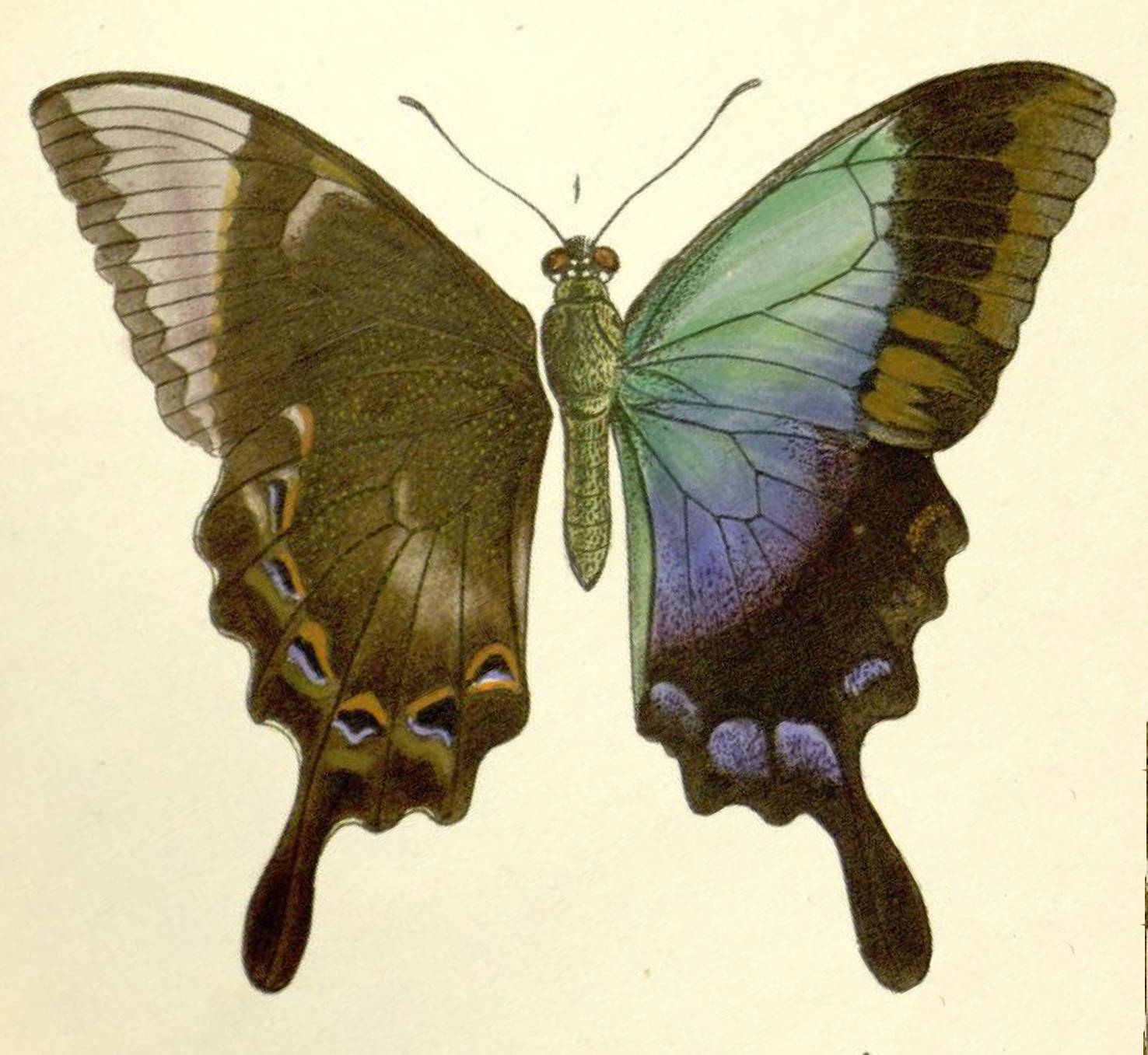
Male Papilio pericles from Wallace, 1865
Wallace's Glorious Begum Butterfly (Nymphalis calydonia Hewitson, 1855: [74] = Agatasa calydonia). Wallace collected a single specimen of this species in Malacca, Peninsular Malaysia. In The Malay Archipelago he writes:
"I was one afternoon walking along a favourite road through the forest, with my gun, when I saw a butterfly on the ground. It was large, handsome, and quite new to me, and I got close to it before it flew away. I then observed that it had been settling on the dung of some carnivorous animal. Thinking it might return to the same spot, I next day after breakfast took my net, and as I approached the place was delighted to see the same butterfly sitting on the same piece of dung, and succeeded in capturing it. It was an entirely new species of great beauty, and has been named by Mr. Hewitson Nymphalis calydona. I never saw another specimen of it, and it was only after twelve years had elapsed that a second individual reached this country from the northwestern part of Borneo."
Hewitson (1855) wrote "This glorious butterfly is beyond description...It is one of the many beautiful new species sent home by Mr. Wallace, who, after suffering shipwreck, and seeing his South American collections burned on board, is now exploring the Indian islands."

Illustration of Nymphalis calydonia from Hewitson, 1855
3) AMPHIBIANS
Wallace's Flying Frog (Rhacophorus nigropalmatus Boulenger, 1895: 170). Discovered by Wallace in Sarawak, Borneo and named by Boulenger many years later (not based on a specimen Wallace collected, however). Wallace writes the following about his capture of this species in The Malay Archipelago:
"One of the most curious and interesting reptiles which I met with in Borneo was a large tree-frog, which was brought me by one of the Chinese workmen. He assured me that he had seen it come down in a slanting direction from a high tree, as if it flew. On examining it, I found the toes very long and fully webbed to their very extremity, so that when expanded they offered a surface much larger than the body......This is, I believe, the first instance known of a "flying frog," and it is very interesting to Darwinians as showing that the variability of the toes which have been already modified for purposes of swimming and adhesive climbing, have been taken advantage of to enable an allied species to pass through the air like the flying lizard."
The watercolour below was painted by Wallace in Sarawak and was used as the basis of the woodcut illustration of this species in The Malay Archipelago.

Watercolour of Rhacophorus nigropalmatus painted by Wallace in Sarawak.
4) BIRDS
Wallace's Hawk-Eagle (Spizaetus nanus Wallace, 1868b: 14 = Nisaetus nanus). Described by Wallace from a single specimen from Sarawak, Borneo collected in 1856. This species ranges from Myanmar and Thailand to Peninsular Malasia, Sumatra and Borneo.

Lithograph of Spizaetus nanus from Wallace, 1868b.
Wallace’s Scops Owl (Scops silvicola Wallace, 1864: 487 = Otus silvicola). Described by Wallace. This species is found on Sumbawa and Flores islands.

Lithograph of Otus silvicola from Hartert,1897. Novit. Zool. 4: 513-528.
Wallace's Scrubfowl (Megapodius wallacei Gray, 1860: 362 = Eulipoa wallacei). This curious species was discovered by Wallace on Halmahera Island, Indonesia. In The Malay Archipelago he wrote:
"I was so fortunate as to discover a new species (Megapodius wallacei), which inhabits Gilolo, Ternate, and Bouru. It is the handsomest bird of the genus, being richly banded with reddish brown on the back and wings; and it differs from the other species in its habits. It frequents the forests of the interior, and comes down to the sea-beach to deposit its eggs, but instead of making a mound, or scratching a hole to receive them, it burrows into the sand to the depth of about three feet obliquely downwards, and deposits its eggs at the bottom. It then loosely covers up the mouth of the hole, and is said by the natives to obliterate and disguise its own footmarks leading to and from the hole, by making many other tracks and scratches in the neighbourhood. It lays its eggs only at night, and at Bouru a bird was caught early one morning as it was coming out of its hole, in which several eggs were found. All these birds seem to be semi-nocturnal, for their loud wailing cries may be constantly heard late into the night and long before daybreak in the morning. The eggs are all of a rusty red colour, and very large for the size of the bird, being generally three or three and a quarter inches long, by two or two and a quarter wide. They are very good eating, and are much sought after by the natives."

Lithograph of Megapodius wallacei from Gray, 1860.
Sulawesi Myna (Basilornis celebensis Gray, 1861: 184). Collected by Wallace on Sulawesi Island, Indonesia.
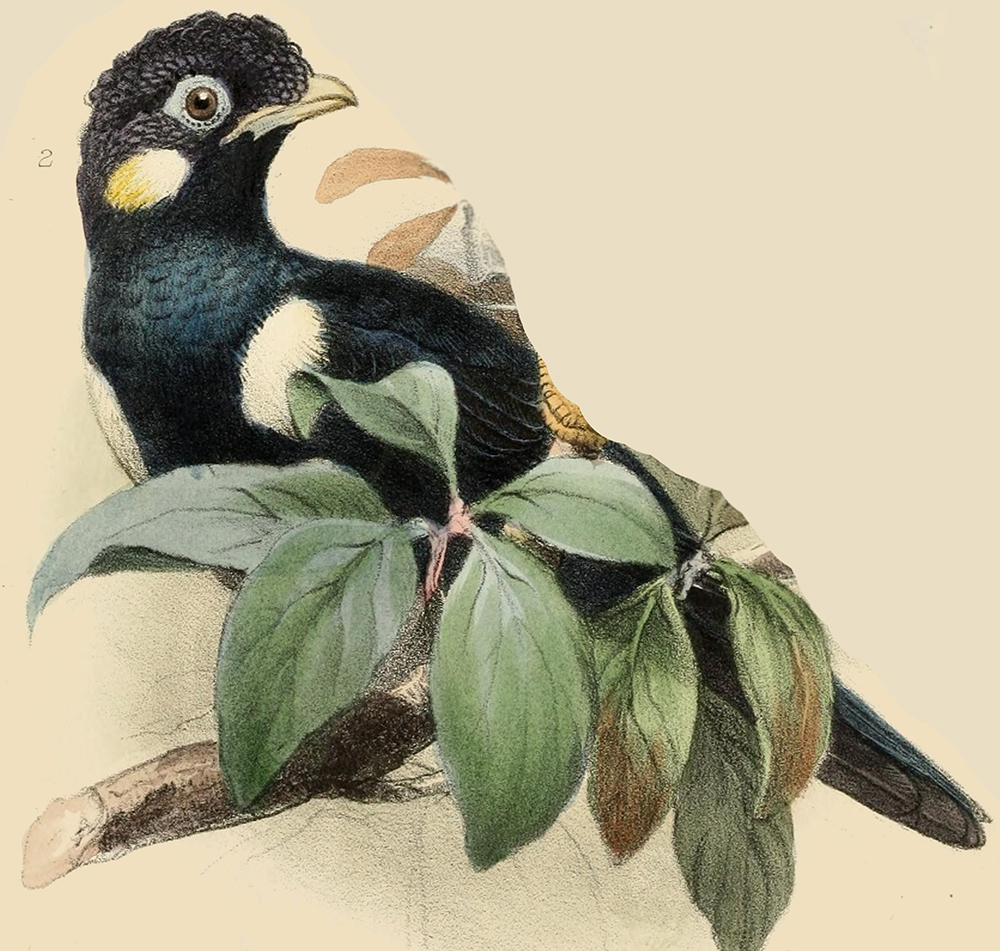
Lithograph of Basilornis celebensis from Wallace, 1861. On the ornithology of Ceram and Waigiou. Ibis 3 (11): 283-291.
Wallace's Standardwing Bird of Paradise (Paradisea (Semioptera) wallacii Gray, 1859: 130 = Semioptera wallacii). Soon after discovering this magnificent bird on Bacan Island, Indonesia, in October 1858, Wallace wrote to his agent Stevens:
"...I believe I have already the finest and most wonderful bird in the island. I had a good mind to keep it a secret, but I cannot resist telling you. I have a new Bird of Paradise! of a new genus!! quite unlike anything yet known, very curious and very handsome!!! When I can get a couple of pairs, I will send them overland, to see what a new Bird of Paradise will really fetch. Had I seen the bird in Ternate, I should never have believed it came from here, so far out of the hitherto supposed region of the Paradiseidae. I consider it the greatest discovery I have yet made..." (Wallace, 1859a)

Lithograph of Semioptera wallacii from Gould's Birds of Australia, Supplement, pl. 52.
Aru Giant Kingfisher/Spangled Kookaburra (Dacelo tyro Gray, 1858: 171). Collected by Wallace on the Aru Islands, Indonesia and also found on New Guinea Island. John Gould wrote in 1860 that this species "…must be regarded as one of the finest of Mr. Wallace’s discoveries..."

Lithograph of Dacelo tyro from Gray, 1858.
White-rumped Kingfisher (Halcyon fulgidus Gould, 1857: 65 = Caridonax fulgidus). Collected by Wallace on Lombok Island, Indonesia; it also occurs on Sumbawa, Flores and Besar. Wallace writes the following about his capture of this species in The Malay Archipelago: "I obtained here eight species of Kingfishers; among which was a very beautiful new one, named by Mr. Gould, Halcyon fulgidus. It was found always in thickets, away from water, and seemed to feed on snails and insects picked up from the ground after the manner of the great Laughing Jackass of Australia."

Lithograph of Halcyon fulgidus from Gould, 1860. Birds of Asia, vol. I no. XLII.
Little Paradise-Kingfisher (Tanysiptera hydrocharis Gray, 1858: 172). Collected by Wallace on the Aru Islands, Indonesia. It is also found on New Guinea.

Lithograph of Tanysiptera hydrocharis from Sharpe's 1868-71. A Monograph of the Alcedinidae: or, Family of Kingfishers.
Yellow-and-green Lorikeet (Trichoglossus flavoviridis Wallace, 1863a: 337). Named by Wallace from specimens from the Sula Islands. It is also found on Sulawesi but the one specimen Wallace had from there "…was carried away by a rat, while drying, and was never recovered."

Lithograph of Trichoglossus flavoviridis from Wallace, 1863a.
Sula Hanging-Parrot (Loriculus sclateri Wallace, 1863a: 336). Wallace collected this species in the Sula Islands, Indonesia and it also occurs on the Banggai Islands. In his description of this species Wallace remarks "I have named it after Dr. Sclater, the indefatigable Secretary to the Zoological Society of London, to whose kind assistance and extensive knowledge of ornithology I am much indebted." Wallace's work on World zoogeographical regions built upon Philip Lutley Sclater's (1829 - 1913) division of the planet into regions according to their bird fauna.
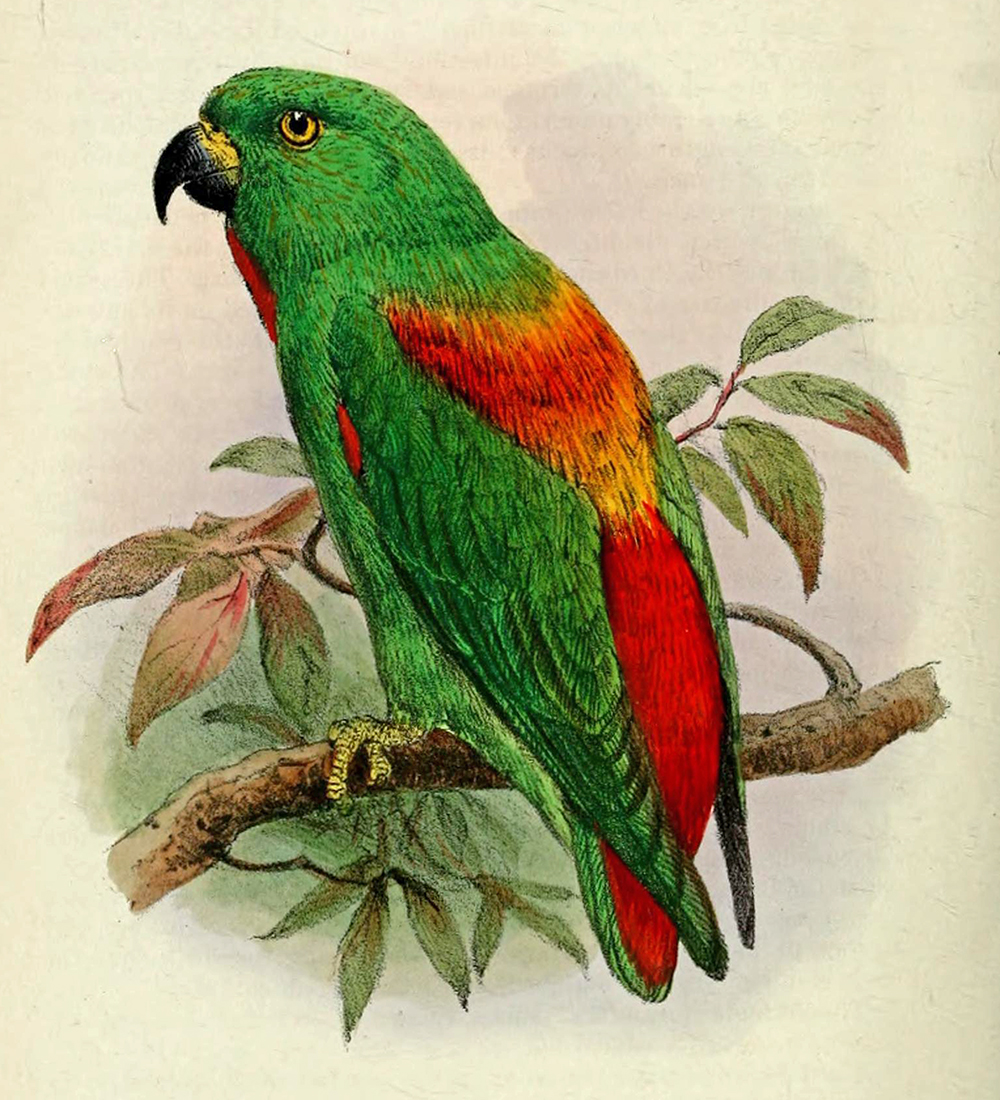
Lithograph of Loriculus sclateri from Wallace, 1863a.
Wallace's Fruit-Dove (Ptilonopus wallacii Gray, 1858: 185). Collected by Wallace on the Aru Islands, Indonesia, it is also found on New Guinea, the southern Moluccas, and Kai island.

Lithograph of Ptilonopus wallacii from Gould's Birds of New Guinea, v. 5, pl. 55
Black-tipped Monarch (Monarcha loricata Wallace, 1863b: 29 = Symposiachrus loricatus). Named by Wallace from specimen(s) from Buru Island, Indonesia and endemic to that island. In The Malay Archipelago he writes:
"My collections in Bouru, though not extensive, were of considerable interest; for out of sixty-six species of birds which I collected there, no less than seventeen were new, or had not been previously found in any island of the Moluccas. Among these were two kingfishers, Tanysiptera acis and Ceyx Cajeli; a beautiful sunbird, Nectarinea proserpina; a handsome little black and white flycatcher, Monarcha loricata, whose swelling throat was beautifully scaled with metallic blue..."
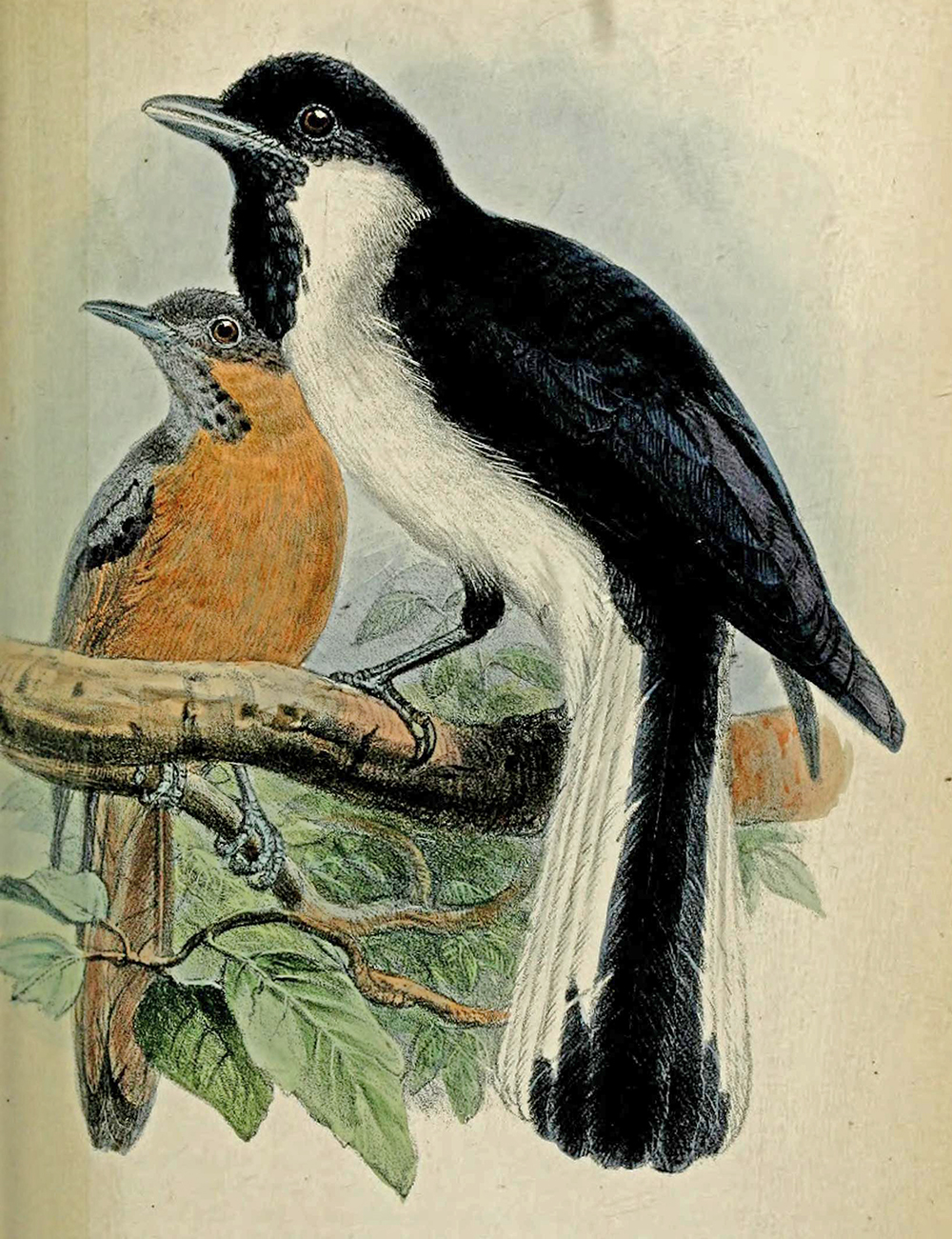
Lithograph of Monarcha loricata from Wallace, 1863b.
Purple Roller (Eurystomus azureus Gray, 1861: 346). Collected by Wallace on Bacan Island, Indonesia. It is found on the north Moluccan islands of Indonesia. This species is classed as Vulnerable by the IUCN.

Lithograph of Eurystomus azureus from ?
Invisible Rail (Habroptila wallacii Gray, 1860: 365). Collected by Wallace on Halmahera Island, Indonesia, and endemic to that island. As its common name suggests, it is a very elusive species, seen by few ornithologists. It lives in drier swamp areas within primary forest, often near the intersection of small rivers and is classed as Vulnerable by the IUCN.

Lithograph of Habroptila wallacii from Gray, 1860.
5) MAMMALS
Wallace's Striped-Faced Fruit Bat (Pteropus wallacei Gray, 1866: 65 = Styloctenium wallacei). Collected by Wallace on Sulawesi Island, Indonesia. It is also found on the Togian Islands of Indonesia.

Illustration of Pteropus wallacei from Gray, 1866.
Common Tube-Nosed Bat (Cynopterus (Uronycteris) albiventer Gray, 1863: 262 = Nyctimene albiventer). Collected by Wallace on Morotai Island, Indonesia. It is a common, widely distributed species, which roosts singly or in mother-infant pairs within understorey to mid-canopy vegetation, usually among dry leaves.

Nyctimene albiventer(?). Weda Bay, Halmahera Island. 2012. Copyright G. Beccaloni
Wallace's Dasyure. (Myoictis wallacii Gray, 1858: 112 = Myoictis wallacei). This marsupial was collected by Wallace in the Aru Islands, Indonesia, and also found in New Guinea Island. Wallace remarked (cited in Gray, 1858) "In houses as destructive as rats to every thing eatable."
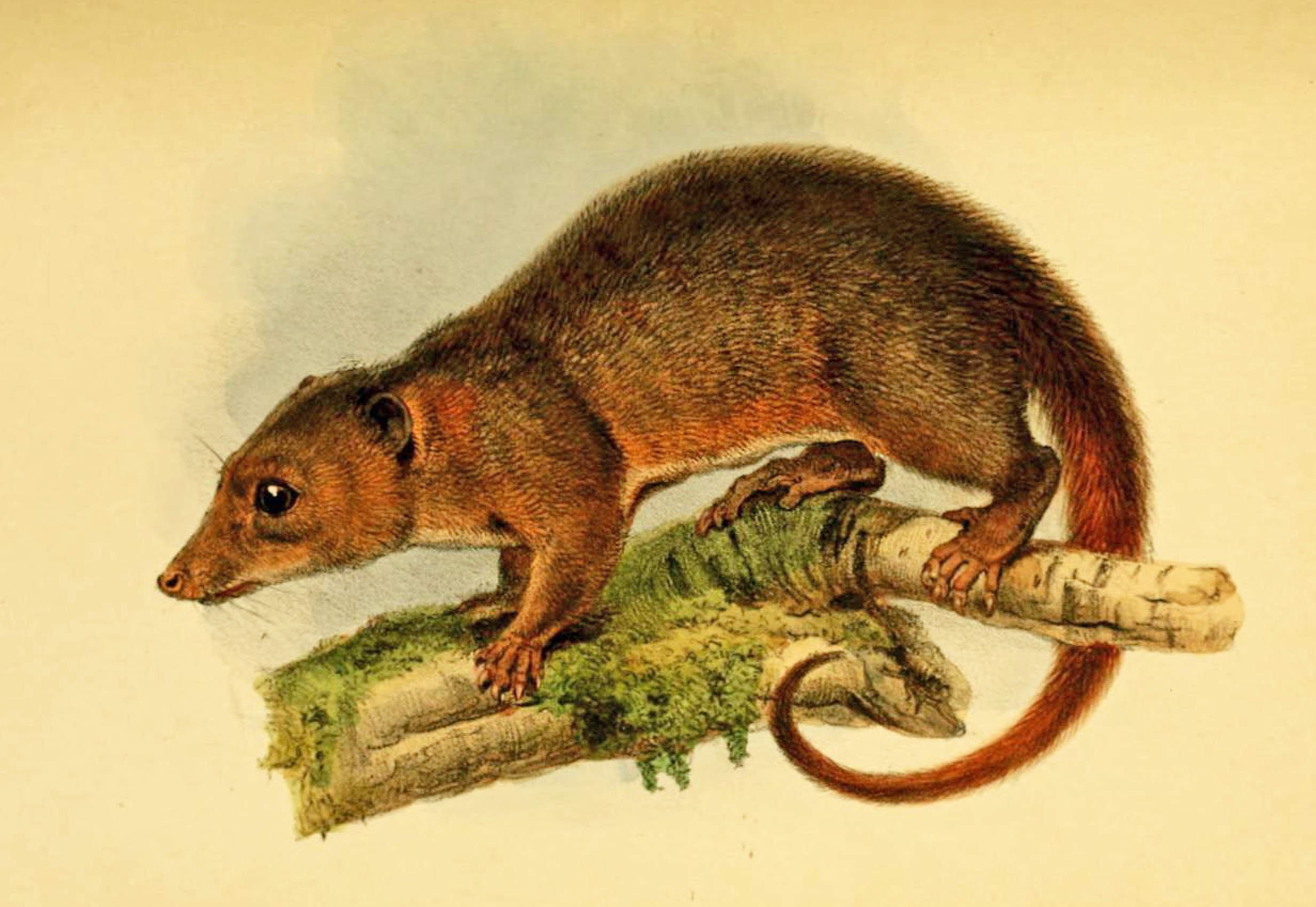
Lithograph of Myoictis wallacii from Gray, 1858.
Striped Possum (Dactylopsila trivirgata Gray, 1858: 111). Named from a female collected by Wallace on the Aru Islands, Indonesia. It is a widespread species found in New Guinea and adjacent islands and Queensland, Australia.

Lithograph of Dactylopsila trivirgata from Gray, 1858.
Moluccan Cuscus (Cuscus ornatus Gray, 1860: 1 = Phalanger ornatus). A marsupial collected by Wallace on Bacan Island, Indonesia in 1859. It is also found on Halmahera and Morotai islands.

Lithograph of Cuscus ornatus from Gray, 1860
Sulawesi Dwarf Cuscus (Cuscus celebensis Gray, 1858: 105 = Strigocuscus celebensis). Collected by Wallace on Sulawesi Island, Indonesia in 1851. It is also found on the islands of Sangihe and Siau. This species feeds on fruit and leaves and is nocturnal. It is one of only two species of cuscus on Sulawesi. They are the most westerly distributed of all marsupials.

Lithograph of Cuscus celebensis from Gray, 1858
Tufted Ground Squirrel (Sciurus macrotis Gray, 1857: 341 = Rheithrosciurus macrotis). Collected by Wallace in Sarawak, Borneo. It is classed as "Vulnerable" by the IUCN. They say of this species: "...only recorded from primary and selectively logged forest in hilly areas at elevations lower than 1,100 m, and forested coastal flats, however, it is not well surveyed in other habitat types. It could be dependent on good quality habitat. Specifically its association with certain tree species, such as Canarium, has been noted (Marshall and Meijaard unpubl. data). It has been observed on occasion in orchards and secondary forests. In primary forest, this species does not seem to be abundant, with only occasional camera trap or observational records (Wearn pers. comm.), although locally the species is commonly photographed on camera traps, especially around specific food trees. The species is diurnal and rare sightings suggest that this species forages primarily on the ground, with rare sightings in the lower and upper canopy. Their diet consists primarily of fruits, nuts and seeds, and with occasional other items like insects taken..."

Lithograph of Sciurus macrotis from Gray, 1857
Bay Cat (Felis badia Gray, 1874: 322 = Catopuma badia). Wallace obtained one skin and skull of this cat in Sarawak, Borneo, which became the holotype of this species. This specimen is in London's Natural History Museum and was received by the museum in 1856 in bad condition, which meant it could not me stuffed. This species is one of the World's most elusive cats, and the first living specimen was captured in 1992. It is classed as Endangered by the IUCN and is listed in CITES Appendix II.
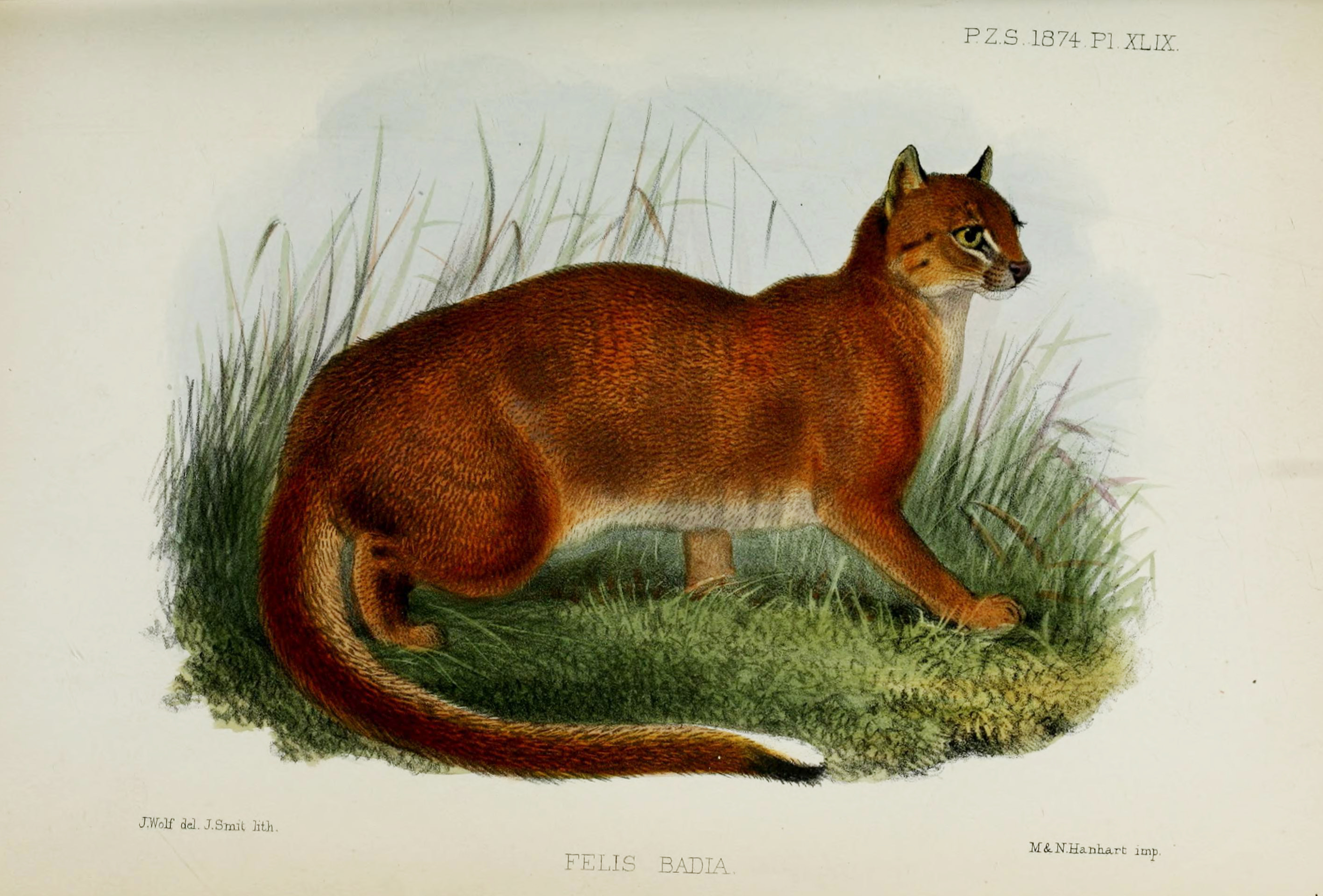
Lithograph plate of Felis badia from Gray, 1874.
REFERENCES
Gray, J. E. 1857. On a new species of squirrel (Sciurus macrotis) from Borneo. Proceedings of the Zoological Society of London 1856 (11 November): 341.
Gray, J. E. 1858. Observations on the genus Cuscus, with the description of a new species. Proceedings of the Zoological Society of London 1858:100-105.
Gray, J. E. 1860. Description of a new species of Cuscus (C. ornatus) from the island of Batchian, with a list of the mammalia collected in that island by Mr. A. R. Wallace. Proceedings of the Zoological Society of London 1860: 1-5.
Gray, J. E. 1863. Description of some new species of Mammalia. Proceedings of the Zoological Society of London 1862: 261-263.
Gray, J. E. 1866. A revision of the genera of pteropine bats (Pteropidae), and the descriptions of some apparently undescribed species. Proceedings of the Zoological Society of London 1866: 62-67.
Gray, J. E. 1874. Description of a new species of cat (Felis badia) from Sarawak. Proceedings of the Zoological Society of London 1874: 322-323.
Hewitson, W. C.1855. Hewitson, 1855. Illustrations of New Species of Exotic Butterflies Selected Chiefly from the Collections of W. Wilson Saunders and William C. Hewitson 3: [74].
Marchant, J. (Ed.). 1916. Alfred Russel Wallace Letters and Reminiscences. Volume 2. London: Cassell. 292 pp.
Parry, F. J. S. 1862. Further descriptions and characters of undescribed lucanoid Coleoptera. Proceedings of the Entomological Society of London, 3 [1861]: 107-113.
Parry, F. J. S. 1864. A catalogue of lucanoid Coleoptera; with illustrations and descriptions of various new and interesting species. Transactions of the Entomological Society of London, (3)2: 1-113.
Pascoe, F. P. 1866. Catalogue of longicorn Coleoptera collected in the island of Penang by James Lamb, Esq. Proceedings of the Zoological Society of London (22 November): 504-536.
Pickard-Cambridge, O. 1897. On some new and little-known spiders (Araneidae). Proceedings of the Zoological Society of London, 64(4, for 1896): 1006-1012.
Smith, F. 1860. Catalogue of hymenopterous insects collected by Mr. A. R. Wallace in the islands of Bachian, Kaisaa, Amboyna, Gilolo, and at Dory in New Guinea. Journal of the Proceedings of the Linnean Society (Zoology), 5 (17b) [Supplement to Vol.4]: 93-143.
Snellen Van Vollenhoven, S. C. 1861. Beschrijving van eenige nieuwe soorten van Lucanidae. Tijdschrift voor Entomologie, 4: 101-115.
Thomson, J. 1858. Wallace, voyage dans l'Asie Orientale. Fragments entomologiques renfermant la description de coléoptères nouveaux ou rares. Archives Entomologiques, 1: 425-460.
Wallace, A. R. 1853. Palm Trees of the Amazon and Their Uses. London: John Van Voorst. 129 pp.
Wallace, A. R. 1855. Description of a new Species of Ornithoptera: Ornithoptera brookiana. Wallace. Proceedings of the Entomological Society of London 1854-1855: 104-105.
Wallace, A. R. 1859a. [Letter dated 29 October 1858, Batchian]. Proceedings of the Zoological Society of London, 27: 129.
Wallace, A. R. 1859b. [Letter dated 28 January 1859, Batchian]. Proceedings of the Entomological Society of London 1858-1859: 70.
Wallace, A. R. 1863a. List of birds from the Sula Islands (East of Celebes), with descriptions of the new species. Proceedings of the Zoological Society of London 1862: 333-346.
Wallace, A. R. 1863b. List of birds collected in the island of Bouru (one of the Moluccas), with descriptions of the new species. Proceedings of the Zoological Society of London 1863: 18-36.
Wallace, A. R. 1865. On the phenomena of variation and geographical distribution as illustrated by the Papilionidae of the Malayan Region. Transactions of the Linnean Society of London, 25 (part I): 1-71.
Wallace, A. R. 1868a. A catalogue of the Cetoniidæ of the Malayan Archipelago, with descriptions of the new species. Transactions of the Entomological Society of London (ser. 3) 4 (part V): 519-601.
Wallace, A. R. 1868b. On the raptorial birds of the Malay Archipelago. Ibis (n.s.) 4(13): 1-27.
